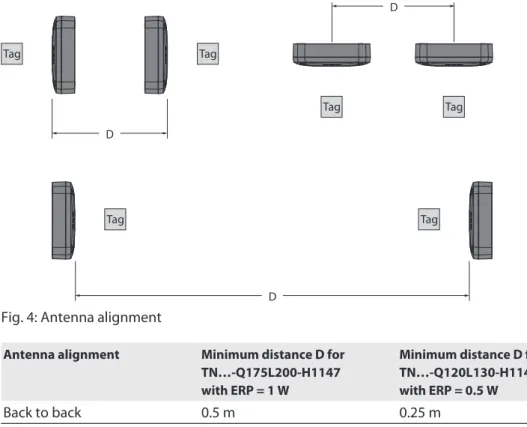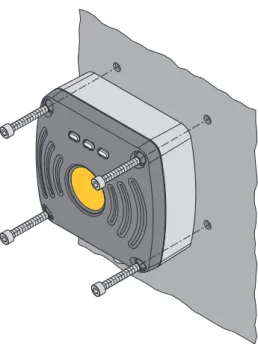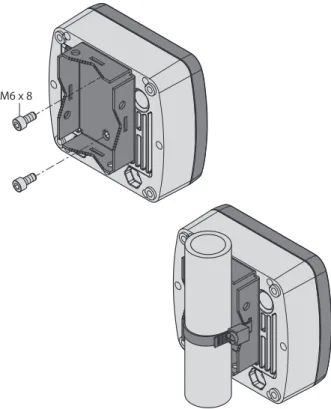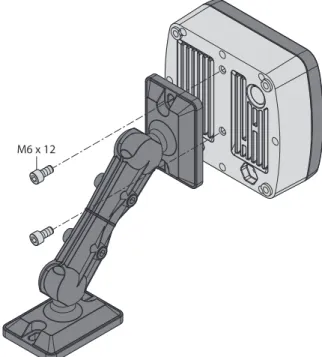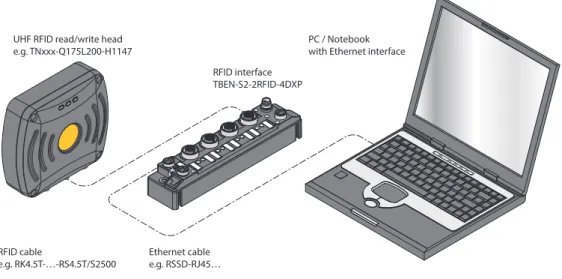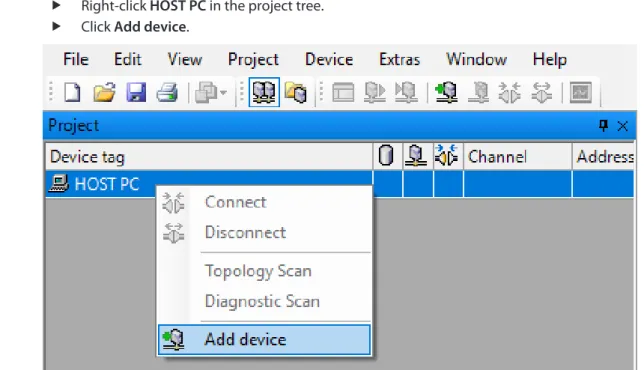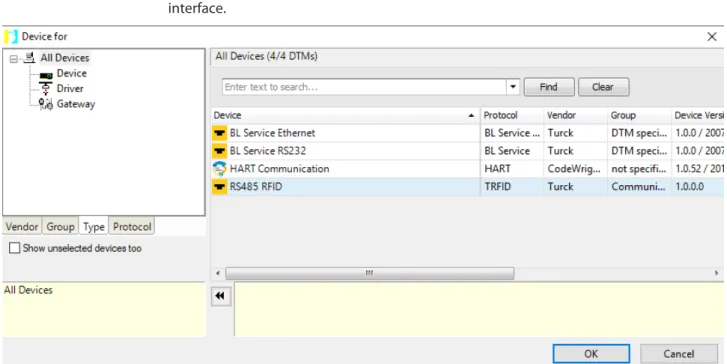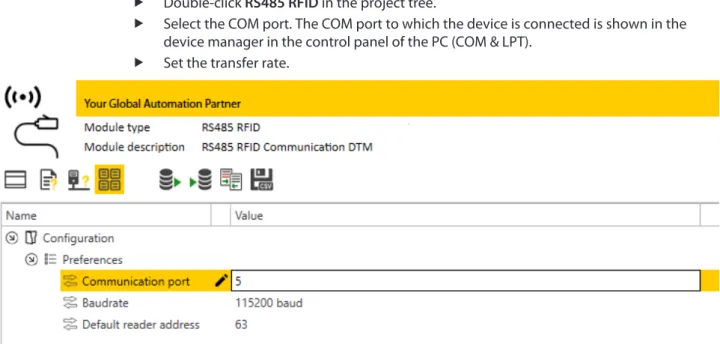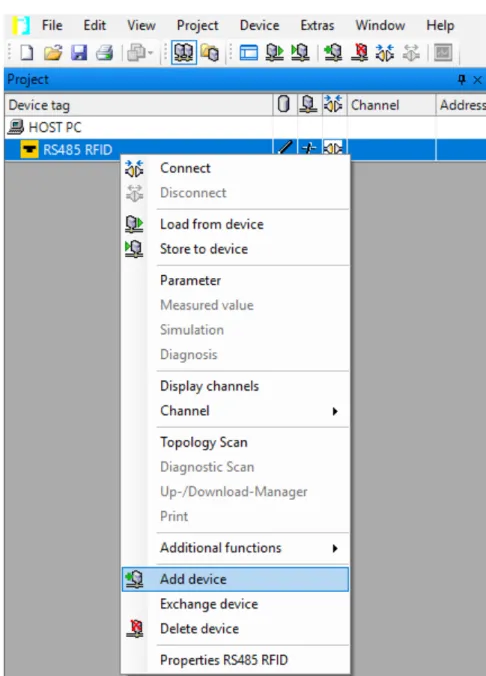Your Global Automation Partner
Instructions for Use
TN…-Q…L…-H1147
UHF Read/Write Heads
V02.00 | 2020/08 3
Contents
1 About These Instructions ... 5
1.1 Target groups... 5
1.2 Explanation of symbols used ... 5
1.3 Other documents ... 5
1.4 Naming convention ... 5
1.5 Feedback about these instructions... 5
2 Notes on the Product ... 6
2.1 Product identification... 6
2.2 Scope of delivery ... 6
2.3 Legal requirements... 7
2.4 Manufacturer and service ... 7
3 For Your Safety... 8
3.1 Intended use... 8
3.2 Obvious misuse... 8
3.3 General safety notes ... 9
4 Product Description ... 10
4.1 Device overview ... 10
4.1.1 Display elements... 10
4.2 Properties and features... 10
4.3 Operating principle... 11
4.4 Functions and operating modes ... 12
4.4.1 Operating frequency ... 12
4.4.2 Combination of UHF read/write heads and tags... 12
4.5 Technical accessories... 13
5 Installing... 14
5.1 Mounting plate fixing... 15
5.2 Mast and tube mounting ... 16
5.3 With the RH-Q240L280/Q280L640 arm bracket... 17
6 Connection... 18
6.1 Wiring diagrams ... 18
7 Commissioning ... 19
7.1 Connecting read/write heads with the PC... 19
7.1.1 Connecting the read/write head with a PC via the RFID interface ... 19
7.1.2 Connecting the read/write head with a PC via the interface converter ... 20
7.1.3 Creating a project in PACTware... 21
7.2 Parameterizing read/write heads with the DTM ... 26
7.2.1 Starting the extended read/write head parameter setting... 27
7.2.2 DTM main menu – overview... 28
7.2.3 Choosing the access level... 29
7.2.4 Calculating radiated power... 30
7.2.5 Switching on Presence sensing mode ... 31
7.2.6 Transferring the RSSI value – communication ... 32
7.2.7 Setting the air interface parameters – EPC Class 1 Gen 2... 33
7.2.8 Error Handling – selectable parameters ... 33
7.2.9 Event Handling – selectable parameters... 33
Contents
7.2.10 Setting the RSSI filter – Post read filter... 34
7.2.11 Setting LED indication – Signaling ... 35
7.3 Testing the read/write head... 36
7.3.1 Starting the RFID Test... 36
7.3.2 Start window – overview... 37
7.3.3 RFID Test – main menu ... 38
7.3.4 RFID Test – Basic test window ... 39
7.3.5 RFID Test – Tag actions window... 40
7.3.6 RFID Test – Logger window ... 42
7.3.7 RFID Test – Reader Status window ... 43
7.3.8 HF diagnosis window ... 43
7.4 Querying device information with the DTM ... 44
8 Operation ... 46
8.1 LED indications ... 46
9 Troubleshooting ... 47
9.1 Rectifying errors ... 48
10 Maintenance... 50
11 Repair... 50
11.1 Returning devices... 50
12 Disposal ... 50
13 Technical Data... 51
13.1 Technical data – TN865… ... 51
13.2 Technical data – TN902… ... 52
13.3 Technical data – TN840/920…... 53
13.4 Technical data – TN917… ... 54
13.5 Technical data – TN866… ... 55
13.6 Technical data – TN902/915…... 56
13.7 Technical data – TN920… ... 57
13.8 Technical data – TN921… ... 58
14 Appendix: Conformity Declarations and Approvals... 59
14.1 EU Declaration of Conformity ... 59
14.2 FCC/IC digital device limitations – TN902-Q120L130-H1147 ... 59
14.3 FCC/IC digital device limitations – TN902-Q175L200-H1147 ... 60
V02.00 | 2020/08 5
1 About These Instructions
These operating instructions describe the structure, functions and the use of the product and will help you to operate the product as intended. Read these instructions carefully before using the product. This is to avoid possible damage to persons, property or the device. Retain the in- structions for future use during the service life of the product. If the product is passed on, pass on these instructions as well.
1.1 Target groups
These instructions are aimed at qualified personal and must be carefully read by anyone mounting, commissioning, operating, maintaining, dismantling or disposing of the device.
1.2 Explanation of symbols used
The following symbols are used in these instructions:
DANGER
DANGER indicates a dangerous situation with high risk of death or severe injury if not avoided.
WARNING
WARNING indicates a dangerous situation with medium risk of death or severe in- jury if not avoided.
CAUTION
CAUTION indicates a dangerous situation of medium risk which may result in minor or moderate injury if not avoided.
NOTICE
NOTICE indicates a situation which may lead to property damage if not avoided.
NOTE
NOTE indicates tips, recommendations and useful information on specific actions and facts. The notes simplify your work and help you to avoid additional work.
u
CALL TO ACTIONThis symbol denotes actions that the user must carry out.
a
RESULTS OF ACTIONThis symbol denotes relevant results of actions.
1.3 Other documents
Besides this document the following material can be found on the Internet at www.turck.com:
n Data sheet n Quick start guide n Configuration manual n Startup manuals
1.4 Naming convention
Common synonyms for "data carriers" include "tag", "transponder", and "mobile storage device". Read/write heads are also described as "transceivers" or "readers".
1.5 Feedback about these instructions
We make every effort to ensure that these instructions are as informative and as clear as pos- sible. If you have any suggestions for improving the design or if some information is missing in the document, please send your suggestions to [email protected].
Notes on the Product
Scope of delivery
2 Notes on the Product
2.1 Product identification
These instructions apply to the following UHF read/write heads:
H1147 Receptacle
Receptacle
H1147 Receptacle for M12 × 1 RFID cable
T N 865 Read/write head – Operating frequency 865 865…868 MHz 866 866…868 MHz 902 902…928 MHz 840/
920 840.5…844.5 MHz &
920.5…924.5 MHz 902/
915 902…907,5 MHz &
915…928 MHz 917 917…920.8 MHz 920 920...926 MHz 921 920...925 MHz Read/write heads, Mounting condition N Non-flush mountable Turck RFID system BL ident
T N 865 – Q120L130 – H1147
Q120L130Design –
Design
Q120L130 Rectangular 120 × 130 × 60 mm
Q175L200 Rectangular 175 × 200 × 60 mm
2.2 Scope of delivery
The scope of delivery includes:
n Read/write head n Quick Start Guide
n Mounting aid incl. mounting bracket and two M6 × 8 screws n Grounding set
n Four screw covers n One screw cap M12
V02.00 | 2020/08 7
2.3 Legal requirements
The devices comply with the following regulations:
Device Region of use Regulations
TN865-Q…L…-H1147 e.g. Europe, Turkey, India
n 2014/30/EU (Electromagnetic compatibility) n 2014/35/EU (low voltage)
n 2014/53/EC (RED Directive) n 2011/65/EU (RoHS)
TN902-Q…L…-H1147 USA FCC Rules Part 15
Canada Industry Canada RSS-210
Mexico IFETEL, Dictamen (electrical safety) TN840/920-Q120L130-
H1147
China SRRC
TN917-Q120L130-H1147 Korea KCC
TN866-Q120L130-H1147 Russia Import license for wireless devices TN902/915-Q120L130-
H1147
Brazil ANATEL
TN920-Q120L130-H1147 Australia ACMA New Zealand RSM
TN921-Q…L…-H1147 Singapore IDMA
NOTE
Additional certification may be required, depending on the region of use. Tests for other national approvals can be carried out and implemented if necessary.
2.4 Manufacturer and service
Hans Turck GmbH & Co. KG Witzlebenstraße 7
45472 Mülheim an der Ruhr Germany
Turck supports you with your projects, from initial analysis to the commissioning of your applic- ation. The Turck product database contains software tools for programming, configuration or commissioning, data sheets and CAD files in numerous export formats. You can access the product database at the following address: www.turck.de/products
For further inquiries in Germany contact the Sales and Service Team on:
n Sales: +49 208 4952-380 n Technology: +49 208 4952-390
Outside Germany, please contact your local Turck representative.
For Your Safety
Obvious misuse
3 For Your Safety
The product is designed according to state-of-the-art technology. However, residual risks still exist. Observe the following warnings and safety notices to prevent damage to persons and property. Turck accepts no liability for damage caused by failure to observe these warning and safety notices.
3.1 Intended use
These devices are designed solely for use in industrial areas.
The BL ident read/write heads are used for contactless data exchange with the BL ident tags in the BL ident UHF RFID system. The following table shows the operating frequency of the devices.
Type code Operating frequency Region
TN865-… 865…868 MHz Europe, Turkey, India
TN902-… 902…928 MHz North America (USA, Canada, Mexico)
TN840/920-… 840.5…844.5 MHz and 920.5…924.5 MHz
China
TN917-… 917…920.8 MHz Korea
TN866-… 866…868 MHz Russia
TN902/915-… 902…907.5 MHz and 915…928 MHz
Brazil
TN920-… 920…926 MHz Australia, New Zealand
TN921-… 920…925 MHz Singapore
These devices may only be started up under the following conditions:
n The particular frequency range is permissible for the use of UHF-RFID.
n The operating frequency range of the devices is compliant with the permissible UHF RFID range of the region.
n A valid certification and/or approval is available for the region of use.
The devices may only be used as described in these instructions. Any other use is not in accord- ance with the intended use. Turck accepts no liability for any resulting damage.
3.2 Obvious misuse
n The devices are not suitable for the protection of persons or property and must not be used in safety-related applications.
n The devices must not be used under water.
V02.00 | 2020/08 9
3.3 General safety notes
n The device only meets the EMC requirements for industrial areas and is not suitable for use in residential areas.
n The device may only be assembled, installed, operated, parameterized and maintained by professionally-trained personnel.
n The device may only be used in accordance with applicable national and international regu- lations, standards and laws.
n Any extended stay within the area of radiation of the UHF read/write heads may be harmful to health. Observe minimum distances from the actively radiating surface of the UHF read/
write head:
Region Max. permissible
total radiant output power
Safety distance Europe, Russia, China 2 W ERP (according to ETSI) > 0.24 m USA, Canada, Brazil, Korea,
Australia, New Zealand
4 W EIRP > 0.30 m
Singapore 0.5 W ERP > 0.24 m
n The radiation of the UHF read/write heads may have an adverse effect on the operation of electrically controlled medical equipment. Keep an additional distance from active radiation sources up to the maximum transmission distance.
Product Description
Properties and features
4 Product Description
The UHF read/write heads have a rectangular design (120 × 130 mm or 175 × 200 mm). The devices are rated to degree of protection IP67 and are contained in an aluminum housing with a plastic front. The power supply and data exchange with the controller are implemented via an RFID interface. A 4-pin M12 × 1 connector is provided for connecting to the RFID interface.
4.1 Device overview
200
175
60
M12 LED
130
120 60
M12 LED
Fig. 1: Dimensions – TN…-Q175L200-H1147
Fig. 2: Dimensions – TN…-Q120L130-H1147
4.1.1 Display elements
Each device is provided with three adjustable LEDs. An audible alarm can also be set using soft- ware tools.
4.2 Properties and features
n Rectangular read/write heads n Active face front
n Writing and reading of passive UHF tags in single and multitag mode
n Read/write distances up to several meters (depending on ambient conditions, the parameter setting of the read/write head and the selected tag)
n Compact design for mounting in restricted spaces n Protection class IP67
V02.00 | 2020/08 11
4.3 Operating principle
The read/write heads are used for contactless data exchange with tags. For this the controller sends commands and data via the interface to the read/write head and receives the corres- ponding response data from the read/write head. The reading of the IDs of all RFID tags in the read area or the writing of an RFID tag with a specific production date are examples of typical commands. To communicate with the tag, the data of the read/write head is coded and trans- ferred via an electromagnetic field, which at the same time supplies the tags with power.
A read/write head contains a transmitter and a receiver, an interface to the interface and a coupling element (coil and dipole antenna) for communicating with the tag. Electromagnetic wave propagation is used for the transmission between read/write head and tag on devices for the UHF range.
Read/write head ICData carrier
UHF: electromagnetic wave
Fig. 3: Operating principle of UHF-RFID
The antenna of the read/write head generates electromagnetic waves. This produces a trans- mission window as a so-called air interface in which the data exchange with the tag takes place.
The size of the transmission window depends on the combination of read/write heads and tags, as well as on the relevant environmental conditions.
Each read/write head can communicate with a number of tags. This requires the read/write head and the tag to operate in the same frequency range. Depending on the power and fre- quency used, the device ranges vary from a few millimeters up to several meters. The specified maximum read/write distances only represent typical values under laboratory conditions without allowing for the effect of materials. The achievable distances may vary due to compon- ent tolerances, the mounting situation in the application, ambient conditions and the effect of materials (particularly metal and liquids).
Product Description
Functions and operating modes
4.4 Functions and operating modes
The devices enable passive UHF tags to be read or written in single and multitag operation. For this the devices form a transmission zone that varies in size and range according to the tags used and the operating conditions of the application. Refer to the data sheets for the applicable maximum read/write distances. The devices can be fully tested, configured and parameterized from a PC using the specified software tools.
4.4.1 Operating frequency
The Turck UHF system uses nationally specified transmission frequencies for the communica- tion between the tags and read/write heads. These national operating frequencies for UHF are the frequency ranges that are individually specified by the national regulation bodies.
The operating frequency of the devices in the UHF band is for example 865…868 MHz for Europe and 902…928 MHz for the USA. The BL ident read/write heads in the UHF band can therefore only be used in the countries they are intended for and must not be put into opera- tion outside of these regions. As the BL ident UHF tags do not radiate their own radio waves, these are suitable for use worldwide.
Turck offers different tag variants that are specially designed and optimized for national fre- quency bands in order to achieve as large a communication range as possible. Wide-band multi-range tags for international use are also available as an alternative.
The various Turck read/write heads support the following operating frequencies:
n 865…868 MHz (e.g. for Europe, Turkey and India) n 866…868 MHz (e.g. for Russia)
n 902…928 MHz (e.g. for USA and Canada) n 920…925 MHz (e.g. for China and Singapore) n 902…907.5 MHz and 915...928 MHz (e.g. for Brazil) n 917…920.8 MHz (e.g. for Korea)
The relevant national specifications for UHF such as frequency range, output and the status of any national regulations can be obtained from the Internet at:
http://www.gs1.org/docs/epcglobal/UHF_Regulations.pdf
For more detailed information please contact the regulation authorities of the country where you wish to use the UHF RFID system.
HF RFID systems can be run parallel to UHF RFID systems in an installation.
4.4.2 Combination of UHF read/write heads and tags
The UHF read/write heads form a transmission zone for which the size depends on the combin- ation of read/write head and tag. The listed maximum read/write distances only represent typ- ical values under laboratory conditions without the effect of materials. The achievable dis- tances may be different due to component tolerances, mounting location in the application, ambient conditions and the effect of materials (particularly metal).
For this reason, the application must be tested in all cases under real conditions (particularly
V02.00 | 2020/08 13
4.5 Technical accessories
The following accessories are supplied with the device:
Dimension drawing Type Ident-No. Description
100
45 ø 6,5 (4x)
61
57 83
RH-Q240L280/Q280L640 7030296 Arm bracket for UHF read/write heads
Installing
5 Installing
The devices can be mounted in any position.
Mount the device with the appropriate fixing accessories.
The minimum distance between two read/write heads using the same frequency depends on the maximum radiant power and the alignment of the antenna.
Tag Tag
Tag Tag
Tag Tag
D
D
D
Fig. 4: Antenna alignment
Antenna alignment Minimum distance D for TN…-Q175L200-H1147 with ERP = 1 W
Minimum distance D for TN…-Q120L130-H1147 with ERP = 0.5 W
Back to back 0.5 m 0.25 m
Side by side 1 m 0.5 m
Front to front 2.5 m 1.25 m
NOTE
The stated values do not take into account the effect of the tags.
V02.00 | 2020/08 15
5.1 Mounting plate fixing
Fasten the device with four M5 × 35 cylinder screws on a pre-drilled mounting plate.
Fig. 5: Screwing the read/write head onto the mounting plate
Installing
Mast and tube mounting
5.2 Mast and tube mounting
Fit the device with the intended mounting aid as shown in the following figure.
M6 x 8
Fig. 6: Mast and tube mounting
V02.00 | 2020/08 17
5.3 With the RH-Q240L280/Q280L640 arm bracket
The RH-Q240L280/Q280L640 arm bracket (Ident-No. 7030296) is not supplied with the device and must be ordered separately.
Secure the read/write head with two M6 × 12 screws on the arm bracket.
Mount arm bracket with read/write head at the intended mounting location.
M6 x 12
Fig. 7: Mounting the read/write head on the arm bracket
Connection
Wiring diagrams
6 Connection
DANGER
Effect on electrically controlled medical devices such as pacemakers Danger to life due to malfunction or failure of medical equipment
Determine and ensure the recommended distances between medical equip- ment and radiation sources.
Connect the device via the M12 plug connector to the RFID interface as shown in the wiring diagrams.
6.1 Wiring diagrams
Connection cables …/S2500
Pin assignment Wiring diagram
4
3 1
2 +
1 RD 3 BK 4 WH 2 BU Data
Data
Connection cables …/S2501
Pin assignment Wiring diagram
4
3 1
2 +
1 BN 3 BU 4 BK 2 WH Data
Data
Connection cables …/S2503
Pin assignment Wiring diagram
4
3 1
2 1 BN
3 BU 4 WH 2 BK
+ – Data Data
V02.00 | 2020/08 19
7 Commissioning
The device is operational automatically once the cables are connected and the power supply is switched on.
The read/write heads can be assigned additional parameters via the DTM in the PACTware 5.0 FDT frame application. FDT and DTM can be downloaded free of charge from www.turck.com.
The planning and preparation of an RFID system require different measures, depending on the application. Further information on this is provided in the RFID engineering manual.
7.1 Connecting read/write heads with the PC
In order to carry out extended parameter setting with the DTM, the read/write head must be connected with a PC. The read/write heads can be connected with a PC via a TBEN-RFID inter- face (e.g. TBEN-S2-2RFID-4DXP) or via the STW-RS485-USB interface converter.
7.1.1 Connecting the read/write head with a PC via the RFID interface
Connect the read/write head to the RFID interface converter using an appropriate connection cable (e.g. RK4.5T-2RS4.5T/S2500).
Connect the RFID interface via a suitable Ethernet cable to the PC.
Connect the RFID interface to a power supply.
UHF RFID read/write head e.g. TNxxx-Q175L200-H1147
RFID interface TBEN-S2-2RFID-4DXP
RFID cable
e.g. RK4.5T-…-RS4.5T/S2500
Ethernet cable e.g. RSSD-RJ45…
PC / Notebook with Ethernet interface
Fig. 8: Connecting the read/write head with a PC via the TBEN-S2-2RFID-4DXP
Commissioning
Connecting read/write heads with the PC
7.1.2 Connecting the read/write head with a PC via the interface converter
The following accessories are required to connect read/write heads to a PC:
n STW-RS485-USB interface converter (Ident-No. 7030354) n STW-RS485-USB-PS power supply unit (Ident-No. 7030355)
Accessories are not supplied with the device and must be ordered separately.
Connect the read/write head to the interface converter using a suitable connection cable (e.g. RK4.5T-2/S2500) according to the following color coding:
STW-RS485-USB …/S2500 plug connectors
…/S2501 plug connectors
…/S2503 plug connectors
VCC Brown (BN) Brown (BN) Red (RD)
GND Blue (BU) Blue (BU) Black (BK)
RS485-A White (WH) Black (BK) White (WH)
RS485-B Black (BK) White (WH) Blue (BU)
Connect a USB cable to the interface converter (USB1.1 type B).
Connect the open end of the USB cable to a free USB port on the PC (USB1.1 type A).
Set the switches on the side of the interface converter for the termination to [ON].
Connect the interface converter via the STW... power supply unit to a power supply.
UHF RFID read/write head e.g. TNxxx-Q175L200-H1147
Interface converter STW-RS485-USB
Power supply STW-RS485-USB-PS RFID cable
e.g. RK4.5T/S2500
PC / Notebook with USB-interface
Fig. 9: Connecting the read/write head via the interface converter with a PC
V02.00 | 2020/08 21
7.1.3 Creating a project in PACTware
Open PACTware.
Right-click HOST PC in the project tree.
Click Add device.
Fig. 10: Adding a device in PACTware
NOTE
The example shows the connection via an interface converter. When using a TBEN- RFID interface, choose the BL Service Ethernet option.
Commissioning
Connecting read/write heads with the PC
Example: Select RS485 RFID to connect the read/write head to the PC via the RS485 interface.
Fig. 11: Example: Selecting RS485 RFID
Double-click RS485 RFID in the project tree.
Select the COM port. The COM port to which the device is connected is shown in the device manager in the control panel of the PC (COM & LPT).
Set the transfer rate.
Fig. 12: Setting up the RS485 interface
V02.00 | 2020/08 23
Right-click RS485 RFID in the project tree.
Click Add device.
Fig. 13: Adding the device to the RS485 interface
Commissioning
Connecting read/write heads with the PC
Select the connected device (example: TN865-Q175L200-H1147).
Confirm the selection with OK or double-click the device.
Fig. 14: Select the connected device (example: TN865-Q175L200-H1147)
V02.00 | 2020/08 25
Right-click the device in the project tree.
Establish a connection.
Fig. 15: Establishing a connection
a The RFID Test and Parameterization functions can be started from the project tree at Additional Functions.
Commissioning
Parameterizing read/write heads with the DTM
7.2 Parameterizing read/write heads with the DTM
The UHF settings of the device can be assigned additional parameters via the DTM.
All the required Turck software components can be downloaded via the Turck Software Man- ager. The Turck Software Manager is available free of charge from www.turck.com.
NOTE
The parameterization function is available in German and English. All parameters are written in the DTM.
The individual read/write heads are available in different variants. When a connection is made to a connected read/write head, the DTM automatically detects the relevant device and deac- tivates menu items that are not supported. The connection cannot be established if a different variant than set in the project tree is connected.
NOTE
Adjustable parameters are indicated in the DTM with green arrows. Fixed paramet- ers are indicated with gray arrows.
Fig. 16: DTM – example of adjustable and fixed parameters
Requirements for extended parameter setting
n PACTware must be installed.
n The DTM for UHF read/write heads must be installed.
n The connection between the read/write head and the PC must be established.
n A project must have been created in PACTware.
V02.00 | 2020/08 27
7.2.1 Starting the extended read/write head parameter setting
Right-click the device.
Start the parameter setting: Choose Parameterization or Online parameterization. The device must be connected to the PC for the Online parameterization.
Fig. 17: Example: starting online parameter setting
Commissioning
Parameterizing read/write heads with the DTM
7.2.2 DTM main menu – overview
Fig. 18: Online parameter setting – main menu
The main menu provides the following functions:
Icon Function Description
Show and hide information bar
Shows the information bar for the connected device and DTM version at the top of the screen.
DTM help Starts the DTM help.
Device help Opens the data sheet of the connected read/write head.
Expert mode ON/OFF Opens the drop-down menu to select the access level. The following access levels are available:
n Basic (default setting) n Advanced
n Administrator (password-protected)
Display channel wise Toggles the view between standard display and channel-wise display.
Load data from database Loads previously stored parameters from the database (e.g. an existing project).
Store data in database Transfers the current read/write head parameters to the database of the current project.
Read data from device Reads the set parameters from the device.
Transmit data to device Transfers the set parameters to the device.
Compare displayed values with data- base
Compares the values displayed in the DTM with the values saved in the database.
CSV export current values Exports the current values from the DTM to a CSV file.
V02.00 | 2020/08 29 The following setup windows can be opened in tabs via the main menu:
n Basic setup n Antenna n Communication n EPC Class1 Gen2 n Error handling n Event handling n Post read filter n Signaling
7.2.3 Choosing the access level
Three access levels are available for setting the device parameters. Different parameters can be set depending on the access level.
NOTE
Modifications made in the Administrator access level can result in serious changes to operation. The Administrator access level is therefore only available for Turck service technicians. All relevant settings for the successful parameter setting of an application are available in the Advanced access level.
Access level Description Initial password
Basic Basic access for configuration and commissioning Not required Advanced Extended access, e.g. for applications Not required Administrator Administrator access for critical security or wireless
settings
Required
The current access level is displayed in the top right screen area of the DTM.
Fig. 19: Display of the access level
Commissioning
Parameterizing read/write heads with the DTM
7.2.4 Calculating radiated power
The effective radiated power (ERP) is the power that is radiated from an antenna into free space. To make it possible to compare the technical properties of different antenna, the power specifications given are always in relation to a reference antenna.
n EIRP = equivalent isotropic radiated power (reference: isotropic antenna) n ERP = effective radiated power (reference: with the length of λ/2)
The radiated power can be stated in watts or in dBm. The following table shows approximate values as a guide for converting between dBm and mW:
dBm mW dBm mW dBm mW dBm mW
1 1.25 9 8 17 50 25 316
2 1.6 10 10 18 63 26 400
3 2 11 13 19 80 27 500
4 2.5 12 16 20 100 28 630
5 3 13 20 21 125 29 800
6 4 14 25 22 160 30 1000
7 5 15 32 23 200 … …
8 6 16 40 24 250 33 2000
The formula for calculating the exact values is: dBm = 10 × lg (P/1 mW)
Set the required radiated power with the slide adjuster in the DTM at Antenna
Ò
RF PowerÒ
Output power.Fig. 20: Setting the radiated power
V02.00 | 2020/08 31
7.2.5 Switching on Presence sensing mode
In order to use the Continuous presence sensing mode command, the Presence sensing mode must be activated in the read/write head. In Presence sensing mode, the read/write heads are automatically switched on as soon as a tag is located in the detection range.
Choose Basic setup
Ò
GeneralÒ
Device mode and set the presence sensing mode option.Fig. 21: Switching on Presence sensing mode
The Advanced access level allows the Tag data delay time and Carrier delay time parameters to be set individually.
n Tag data delay time: Time in which the read/write head searches for a tag. If a tag is found, the field is switched on. In the Basic access level, the parameter is set by default to 100 ms.
n Carrier delay time: Time until the read/write head switches off the field after the last read operation. In the Basic access level, the parameter is set by default to 65535 ms.
NOTE
Report mode is recommended for the RFID test since the read tag information items appear in the RFID test window and do not have to be polled individually.
Commissioning
Parameterizing read/write heads with the DTM
7.2.6 Transferring the RSSI value – communication
The Communication tab is used to set the parameters for the configuration of the deBus messages. All parameters and the settable values are written in the DTM.
Example: switch on RSSI transmission
Switch on RSSI transmission: choose Communication
Ò
Message data contentÒ
Transponder RSSI and select the enabled option.
a The RSSI value is displayed with the inventory in the read data.
Fig. 22: Switching on RSSI transmission
V02.00 | 2020/08 33
7.2.7 Setting the air interface parameters – EPC Class 1 Gen 2
The EPC Class1 Gen2 tab is used to set the EPC Class1 Gen2 parameters for the air interface.
The parameters set are used if the read/write head performs an Inventory command. All para- meters and the settable values are written in the DTM.
Fig. 23: Setting air interface parameters
7.2.8 Error Handling – selectable parameters
The behavior of the read/write head in response to errors (e.g. LED behavior) can be set in the Error Handling tab. All parameters and the settable values are written in the DTM.
7.2.9 Event Handling – selectable parameters
The behavior of the read/write head in response to different events (e.g. LED behavior) can be set in the Event Handling tab. All parameters and the settable values are written in the DTM.
Commissioning
Parameterizing read/write heads with the DTM
7.2.10 Setting the RSSI filter – Post read filter
The Post read filter tab enables parameters to be set in order to filter event messages.
The set filters do not reduce the data traffic on the air interface and are not suitable for multi- tag applications with many tags or high passing speeds. All parameters and the settable values are written in the DTM.
Example: set the RSSI filter
An RSSI filter makes it possible to prevent unwanted read operations. All read operations with an RSSI outside of the set limit values are filtered out and not displayed.
At Post read filter
Ò
RSSI filter switch on the RSSI filter.Fig. 24: Switching on the RSSI filter
V02.00 | 2020/08 35
Set the limit values at Post read filter
Ò
RSSI filterÒ
Lower threshold.a Example: all read operations below an RSSI value of -45 dBm are filtered out.
Fig. 25: Example – setting the limit value for RSSI
7.2.11 Setting LED indication – Signaling
The Signaling tab enables the default settings for the USER LEDs to be edited. All parameters and the settable values are written in the DTM.
Commissioning
Testing the read/write head
7.3 Testing the read/write head
The following functions can be executed via the RFID Test in the DTM:
n Displaying read data
n Displaying the protocol of the communication between host or PC and read/write head n Logging of the interface communication between host or PC and read/write head n Sending of user-specific deBus commands
n Writing of tags with a user-defined number n Sending tag-specific commands
Requirements for the RFID Test
n PACTware must be installed.
n The DTM for UHF read/write heads must be installed.
n The connection between the read/write head and the PC must be established.
n A project must have been created in PACTware.
7.3.1 Starting the RFID Test
Right-click the device in the project tree.
In the context menu choose Additional functions
Ò
RFID Test.V02.00 | 2020/08 37
7.3.2 Start window – overview
The RFID Test window consists of the following elements:
n Main menu n Basic test n Tag actions n Reader Status n Logger
Fig. 27: RFID Test – overview of the start window
Commissioning
Testing the read/write head
7.3.3 RFID Test – main menu
Fig. 28: RFID Test – main menu
The main menu provides the following functions:
Icon Function Description
DTM help Starts the DTM help.
Trigger start/ON or
Trigger stop/OFF
Starts the trigger for command execution (standard view).
Ends the trigger for command execution (displayed after clicking the start button).
Configure message content Displays the content to be transferred with a read operation.
The following can be selected:
n Phase n RSSI n Socket n Time
Switch mode (report/polling) Switches between Report mode (automatic read/write) and polling mode (read/write started through an explicit polling command).
Get read/write head status Calls the status of the read/write head and provides the in- formation in the Logger window.
Get read/write head version Calls the following information from the read/write head and provides the information in the Logger window:
n Hardware revision n Firmware status n Serial number
Reset the read/write head Offers three ways of resetting the read/write head:
n Voltage reset
n Factory reset: Reset to factory settings n Reset read/write head status
When resetting to factory settings, any modified transfer rate or RS485 address is not changed because the read/write head could not otherwise be addressed any longer.
V02.00 | 2020/08 39
7.3.4 RFID Test – Basic test window
Fig. 29: RFID Test – Basic test window
The following functions are available in the Basic test window:
Icon Function Description
Polling Shows the first tag in the polling memory of the device in the tag list. The function is only available in polling mode.
Poll all Shows all tags in the polling memory of the device in the tag list. The function is only available in polling mode.
Clear polled tags from read/write head
Clears the polling memory of the read/write head.
Group tag list Combines readings of tags with the same EPC.
CSV export current values Saves the tag list in CSV format.
Clear tag list Deletes the list of displayed tags.
The queried data is displayed in the tag list. The content of the message can be set via the Configure message content function.
NOTE
If the polling memory of the read/write head is full, the ERR LED is lit red and indic- ates an internal error.
Commissioning
Testing the read/write head
7.3.5 RFID Test – Tag actions window
The functions in the Tag actions window are available if a tag is selected in the tag list of the Basic test window.
Fig. 30: RFID Test – Tag actions window
The following functions are available in the Tag actions window:
Icon Function Description
Read RFID tag memory Starts the read operation.
The chip type is automatically displayed. One word is always read with the first read operation. The following parameters can be set for other read operations:
n Memory bank (TID, EPC/UID, PC, access password or kill password)
n Start word n Number of words
The read data is displayed in the Data area.
Write RFID tag memory Starts the write operation.
The chip type is automatically displayed. The following parameters can be set for the write operations:
n Memory bank (TID, EPC/UID, PC, access password or kill password)
n Start word n Number of words
Data to be written is displayed in the Data area.
Auto-increment The EPC is incremented automatically by 1.
Auto-decrement The EPC is decremented automatically by 1.
V02.00 | 2020/08 41
Example: execute tag actions
Position tag in detection range of the read/write head.
Activate the trigger for the read/write head in the main menu.
Fig. 31: Main menu – activating trigger
Basic test window: execute polling command in order to display tag in the tag list.
Basic test window: select tag from the tag list.
Fig. 32: Basic test – tag selection
Tag actions window: To read, select Memory location, Start word or Word length and click the appropriate icon.
To write enter values under Data and confirm with OK
Fig. 33: Execute tag action (example: read)
Commissioning
Testing the read/write head
a Successful access is displayed via the status message at the bottom of the window.
Fig. 34: Example: read successful
7.3.6 RFID Test – Logger window
The Logger window displays read/write information and error messages. The list can be cleared via the Delete button.
Fig. 35: Messages in the Logger window
V02.00 | 2020/08 43
7.3.7 RFID Test – Reader Status window
The Reader Status window displays the following parameters:
n Ambient temperature: Temperature inside the read/write head n PA temperature: Temperature of the power amplifier
n Transceiver temperature: Temperature of the read/write head chip n Transmit power: Effective radiated power (ERP)
n Reverse power: The power radiated back to the electronics
Fig. 36: Messages in the Reader Status window
The list can be cleared via the Delete button.
7.3.8 HF diagnosis window
Interference frequencies affecting the respective channels are displayed in the HF diagnosis window.
Fig. 37: HF diagnosis window
The following functions can be executed in the HF diagnosis window:
Icon Function Description
Start/stop HF diagnosis Starts or closes the HF diagnosis.
Clear values Deletes the displayed values.
Commissioning
Querying device information with the DTM
7.4 Querying device information with the DTM
The DTM provides access to hardware and software information as well as regulations on the connected device.
Right-click the device in the project tree.
Choose Additional functions
Ò
Identify.Fig. 38: Calling up Identification
V02.00 | 2020/08 45 a The DTM shows the available information on the device according to the selected access
level.
Fig. 39: Device information for TN865-Q175L200-H1147 in the Advanced access level
Operation
LED indications
8 Operation
8.1 LED indications
The devices are provided with three LEDs for displaying the status of the device. The indication functions can be adjusted for the specific application via the DTM.
The LEDs are factory set with the following indication functions after a voltage reset:
LED State Meaning
1 (operating state) Off No operating voltage
Green Operating voltage connected
Off 0.2 s Tag detected
2 (state of the wireless field) Off Wireless field deactivated
Yellow Wireless field activated
3 (errors) Off No internal error
Red Internal error detected
V02.00 | 2020/08 47
9 Troubleshooting
If the device does not work as expected, proceed as follows:
Exclude environmental disturbances.
Check the connections of the device for errors.
Check device for parameterization errors.
If the malfunction persists, the device is faulty. In this case, decommission the device and replace it with a new device of the same type.
Troubleshooting
Rectifying errors
9.1 Rectifying errors
Errors are displayed by an ERR LED lit red on the device.
Calling error messages in the DTM and rectifying them
NOTE
Contact Turck if the error persists after the read/write head is reset.
Right-click the device in the project tree.
Select Diagnosis in the context menu.
V02.00 | 2020/08 49 a The diagnosis window opens in the DTM.
Fig. 41: DTM – diagnosis
Rectifying error messages:
Click the Reset read/write head button in the RFID Test main menu.
Select Reset the read/write head in the drop-down menu.
a The read/write head is reset.
Fig. 42: DTM – Reset the read/write head
Maintenance
Returning devices
10 Maintenance
Ensure that the plug connections and cables are always in good condition.
The devices are maintenance-free, clean dry if required.
11 Repair
The device must not be repaired by the user. The device must be decommissioned if it is faulty.
Observe our return acceptance conditions when returning the device to Turck.
11.1 Returning devices
Returns to Turck can only be accepted if the device has been equipped with a Decontamination declaration enclosed. The decontamination declaration can be downloaded from
https://www.turck.de/en/retoure-service-6079.php
and must be completely filled in, and affixed securely and weather-proof to the outside of the packaging.
12 Disposal
The devices must be disposed of correctly and must not be included in general household garbage.
V02.00 | 2020/08 51
13 Technical Data
13.1 Technical data – TN865…
Technical data TN865-Q120… TN865-Q175…
Mounting condition Non-flush Non-flush
Ambient temperature -25…+50 °C -25…+50 °C
Operating voltage 12…24 VDC 12…24 VDC
Data transmission Electromagnetic AC field
Electromagnetic AC field
Operating frequency 865…868 MHz 865…868 MHz
Wireless communication and protocol standards
ISO 18000-6C EN 302208 EPCglobal Gen 2
ISO 18000-6C EN 302208 EPCglobal Gen 2
Channel distance 200/600 kHz 200/600 kHz
Output power 0.5 W (ERP), adjustable 1 W (ERP), adjustable
Antenna polarization Clockwise Clockwise
Antenna half power beam width
110° 90°
Read-write distance max. 1500 mm 4000 mm
Output function 4-wire, read/write 4-wire, read/write
Design Rectangular Rectangular
Dimensions 130 × 120 × 60 mm 200 × 175 × 60 mm
Housing material Aluminum, AL, silver Aluminum, AL, silver Material of active face Plastic, ABS, black Plastic, ABS, black Electrical connection Male connector, M12 x 1 Male connector, M12 x 1
Vibration resistance 55 Hz (1 mm) 55 Hz (1 mm)
Shock resistance 30 g (11 ms) 30 g (11 ms)
Type of protection IP67 IP67
MTTF 51 years acc. to SN 29500
(Ed. 99) 40°C
51 years acc. to SN 29500 (Ed. 99)
40°C
Technical Data
Technical data – TN902…
13.2 Technical data – TN902…
Technical data TN902-Q120… TN902-Q175…
Mounting condition Non-flush Non-flush
Ambient temperature -25…+50 °C -25…+50 °C
Operating voltage 12…24 VDC 12…24 VDC
Data transmission Electromagnetic AC field
Electromagnetic AC field
Operating frequency 902…928 MHz 902…928 MHz
Wireless communication and protocol standards
ISO 18000-6C EPCglobal Gen 2
ISO 18000-6C EPCglobal Gen 2
Channel distance 500 kHz 500 kHz
Output power 0.5 W (ERP), adjustable 1 W (ERP), adjustable
Antenna polarization Clockwise Clockwise
Antenna half power beam width
110° 90°
Read-write distance max. 1500 mm 4000 mm
Output function 4-wire, read/write 4-wire, read/write
Design Rectangular Rectangular
Dimensions 130 × 120 × 60 mm 200 × 175 × 60 mm
Housing material Aluminum, AL, silver Aluminum, AL, silver Material of active face Plastic, ABS, black Plastic, ABS, black Electrical connection Male connector, M12 x 1 Male connector, M12 x 1
Vibration resistance 55 Hz (1 mm) 55 Hz (1 mm)
Shock resistance 30 g (11 ms) 30 g (11 ms)
Type of protection IP67 IP67
MTTF 51 years acc. to SN 29500
(Ed. 99) 40°C
51 years acc. to SN 29500 (Ed. 99)
40°C
V02.00 | 2020/08 53
13.3 Technical data – TN840/920…
Technical data TN840/920-Q120… TN840/920-Q175…
Mounting condition Non-flush Non-flush
Ambient temperature -25…+50 °C -25…+50 °C
Operating voltage 12…24 VDC 12…24 VDC
Data transmission Electromagnetic AC field
Electromagnetic AC field
Operating frequency 920…925 MHz 920…925 MHz
Wireless communication and protocol standards
ISO 18000-6C EPCglobal Gen 2
ISO 18000-6C EPCglobal Gen 2
Channel distance 250 kHz 250 kHz
Output power 0.5 W (ERP), adjustable 1 W (ERP), adjustable
Antenna polarization Clockwise Clockwise
Antenna half power beam width
110° 90°
Read-write distance max. 1500 mm 4000 mm
Output function 4-wire, read/write 4-wire, read/write
Design Rectangular Rectangular
Dimensions 130 × 120 × 60 mm 200 × 175 × 60 mm
Housing material Aluminum, AL, silver Aluminum, AL, silver Material of active face Plastic, ABS, black Plastic, ABS, black Electrical connection Male connector, M12 x 1 Male connector, M12 x 1
Vibration resistance 55 Hz (1 mm) 55 Hz (1 mm)
Shock resistance 30 g (11 ms) 30 g (11 ms)
Type of protection IP67 IP67
MTTF 51 years acc. to SN 29500
(Ed. 99) 40°C
51 years acc. to SN 29500 (Ed. 99)
40°C
Technical Data
Technical data – TN917…
13.4 Technical data – TN917…
Technical data TN917-Q120… TN917-Q175…
Mounting condition Non-flush Non-flush
Ambient temperature -25…+50 °C -25…+50 °C
Operating voltage 12…24 VDC 12…24 VDC
Data transmission Electromagnetic AC field
Electromagnetic AC field
Operating frequency 917…920.8 MHz 917…920.8 MHz
Wireless communication and protocol standards
ISO 18000-6C EPCglobal Gen 2
ISO 18000-6C EPCglobal Gen 2
Channel distance 600 kHz 600 kHz
Output power 0.5 W (ERP), adjustable 1 W (ERP), adjustable
Antenna polarization Clockwise Clockwise
Antenna half power beam width
110° 90°
Read-write distance max. 1500 mm 4000 mm
Output function 4-wire, read/write 4-wire, read/write
Design Rectangular Rectangular
Dimensions 130 × 120 × 60 mm 200 × 175 × 60 mm
Housing material Aluminum, AL, silver Aluminum, AL, silver Material of active face Plastic, ABS, black Plastic, ABS, black Electrical connection Male connector, M12 x 1 Male connector, M12 x 1
Vibration resistance 55 Hz (1 mm) 55 Hz (1 mm)
Shock resistance 30 g (11 ms) 30 g (11 ms)
Type of protection IP67 IP67
MTTF 51 years acc. to SN 29500
(Ed. 99) 40°C
51 years acc. to SN 29500 (Ed. 99)
40°C
V02.00 | 2020/08 55
13.5 Technical data – TN866…
Technical data TN866-Q120… TN866-Q175…
Mounting condition Non-flush Non-flush
Ambient temperature -25…+50 °C -25…+50 °C
Operating voltage 12…24 VDC 12…24 VDC
Data transmission Electromagnetic AC field
Electromagnetic AC field
Operating frequency 866…868 MHz 866…868 MHz
Wireless communication and protocol standards
ISO 18000-6C EPCglobal Gen 2
ISO 18000-6C EPCglobal Gen 2
Channel distance 200 kHz 200 kHz
Output power 0.5 W (ERP), adjustable 1 W (ERP), adjustable
Antenna polarization Clockwise Clockwise
Antenna half power beam width
110° 90°
Read-write distance max. 1500 mm 4000 mm
Output function 4-wire, read/write 4-wire, read/write
Design Rectangular Rectangular
Dimensions 130 × 120 × 60 mm 200 × 175 × 60 mm
Housing material Aluminum, AL, silver Aluminum, AL, silver Material of active face Plastic, ABS, black Plastic, ABS, black Electrical connection Male connector, M12 x 1 Male connector, M12 x 1
Vibration resistance 55 Hz (1 mm) 55 Hz (1 mm)
Shock resistance 30 g (11 ms) 30 g (11 ms)
Type of protection IP67 IP67
MTTF 51 years acc. to SN 29500
(Ed. 99) 40°C
51 years acc. to SN 29500 (Ed. 99)
40°C
Technical Data
Technical data – TN902/915…
13.6 Technical data – TN902/915…
Technical data TN902/915-Q120… TN902/915-Q175…
Mounting condition Non-flush Non-flush
Ambient temperature -25…+50 °C -25…+50 °C
Operating voltage 12…24 VDC 12…24 VDC
Data transmission Electromagnetic AC field
Electromagnetic AC field
Operating frequency 915…928 MHz 915…928 MHz
Wireless communication and protocol standards
ISO 18000-6C EPCglobal Gen 2
ISO 18000-6C EPCglobal Gen 2
Channel distance 250 kHz 250 kHz
Output power 0.5 W (ERP), adjustable 1 W (ERP), adjustable
Antenna polarization Clockwise Clockwise
Antenna half power beam width
110° 90°
Read-write distance max. 1500 mm 4000 mm
Output function 4-wire, read/write 4-wire, read/write
Design Rectangular Rectangular
Dimensions 130 × 120 × 60 mm 200 × 175 × 60 mm
Housing material Aluminum, AL, silver Aluminum, AL, silver Material of active face Plastic, ABS, black Plastic, ABS, black Electrical connection Male connector, M12 x 1 Male connector, M12 x 1
Vibration resistance 55 Hz (1 mm) 55 Hz (1 mm)
Shock resistance 30 g (11 ms) 30 g (11 ms)
Type of protection IP67 IP67
MTTF 51 years acc. to SN 29500
(Ed. 99) 40°C
51 years acc. to SN 29500 (Ed. 99)
40°C
V02.00 | 2020/08 57
13.7 Technical data – TN920…
Technical data TN920-Q120… TN920-Q175…
Mounting condition Non-flush Non-flush
Ambient temperature -25…+50 °C -25…+50 °C
Operating voltage 12…24 VDC 12…24 VDC
Data transmission Electromagnetic AC field
Electromagnetic AC field
Operating frequency 920…926 MHz 920…926 MHz
Wireless communication and protocol standards
ISO 18000-6C EPCglobal Gen 2
ISO 18000-6C EPCglobal Gen 2
Channel distance 500 kHz 500 kHz
Output power 0.5 W (ERP), adjustable 1 W (ERP), adjustable
Antenna polarization Clockwise Clockwise
Antenna half power beam width
110° 90°
Read-write distance max. 1500 mm 4000 mm
Output function 4-wire, read/write 4-wire, read/write
Design Rectangular Rectangular
Dimensions 130 × 120 × 60 mm 200 × 175 × 60 mm
Housing material Aluminum, AL, silver Aluminum, AL, silver Material of active face Plastic, ABS, black Plastic, ABS, black Electrical connection Male connector, M12 x 1 Male connector, M12 x 1
Vibration resistance 55 Hz (1 mm) 55 Hz (1 mm)
Shock resistance 30 g (11 ms) 30 g (11 ms)
Type of protection IP67 IP67
MTTF 51 years acc. to SN 29500
(Ed. 99) 40°C
51 years acc. to SN 29500 (Ed. 99)
40°C
Technical Data
Technical data – TN921…
13.8 Technical data – TN921…
Technical data TN921-Q120… TN921-Q175…
Mounting condition Non-flush Non-flush
Ambient temperature -25…+50 °C -25…+50 °C
Operating voltage 12…24 VDC 12…24 VDC
Data transmission Electromagnetic AC field
Electromagnetic AC field
Operating frequency 920…925 MHz 920…925 MHz
Wireless communication and protocol standards
ISO 18000-6C EPCglobal Gen 2
ISO 18000-6C EPCglobal Gen 2
Channel distance 500 kHz 500 kHz
Output power 0.5 W (ERP), adjustable 1 W (ERP), adjustable
The max. output power of the devices is currently limited to 0.5 W ERP due to licensing.
Antenna polarization Clockwise Clockwise
Antenna half power beam width
110° 90°
Read-write distance max. 1500 mm 4000 mm
Output function 4-wire, read/write 4-wire, read/write
Design Rectangular Rectangular
Dimensions 130 × 120 × 60 mm 200 × 175 × 60 mm
Housing material Aluminum, AL, silver Aluminum, AL, silver Material of active face Plastic, ABS, black Plastic, ABS, black Electrical connection Male connector, M12 x 1 Male connector, M12 x 1
Vibration resistance 55 Hz (1 mm) 55 Hz (1 mm)
Shock resistance 30 g (11 ms) 30 g (11 ms)
Type of protection IP67 IP67
MTTF 51 years acc. to SN 29500
(Ed. 99) 40°C
51 years acc. to SN 29500 (Ed. 99)
40°C
V02.00 | 2020/08 59
14 Appendix: Conformity Declarations and Approvals
14.1 EU Declaration of Conformity
Hans Turck GmbH & Co. KG hereby declares that the TN-865-… wireless system complies with directive 2014/53/EU. The complete text of the EU declaration of conformity can be obtained from the following Internet address: www.turck.com.
14.2 FCC/IC digital device limitations – TN902-Q120L130-H1147
FCC ID: YQ7TN902-Q120L131 IC ID: 8821A-T902Q12L14
This device complies with Part 15 of the FCC Rules and Industry Canada license-exempt RSS standard(s). Operation is subject to the following two conditions:
(1) this device may not cause harmful interference, and
(2) this device must accept any interference received, including interference that may cause un- desired operation.
Changes or modifications not expressly approved by the party responsible for compliance could void the user’s authority to operate the equipment.
Le présent appareil est conforme aux CNR d’Industrie Canada applicables aux appareils radio exempts de licence. L’exploitation est autorisée aux deux conditions suivantes :
(1) l’appareil ne doit pas produire de brouillage, et
(2) l’utilisateur de l’appareil doit accepter tout brouillage radioélectrique subi, même si le brouillage est susceptible d’en compromettre le fonctionnement.
Note: This equipment has been tested and found to comply with the limits for a Class A digital device, pursuant to part 15 of the FCC Rules. These limits are designed to provide reasonable protection against harmful interference when the equipment is operated in a commercial en- vironment.
This equipment generates, uses, and can radiate radio frequency energy and, if not installed and used in accordance with the instruction manual, may cause harmful interference to radio communications. Operation of this equipment in a residential area is likely to cause harmful in- terference in which case the user will be required to correct the interference at his own ex- pense.
This equipment complies with FCC/IC exposure limits set forth for an uncontrolled environ- ment.
This equipment should be installed and operated with minimum distance 30 cm between the radiator & your body.
CAN ICES-3 (A)/NMB-3(A)
Use only with listed LPS or class 2 power supply!
Appendix: Conformity Declarations and Approvals
FCC/IC digital device limitations – TN902-Q175L200-H1147
14.3 FCC/IC digital device limitations – TN902-Q175L200-H1147
FCC ID: YQ7TN902-Q175L201 IC: 8821A-T902Q17L21
This device complies with Part 15 of the FCC Rules and Industry Canada license-exempt RSS standard(s). Operation is subject to the following two conditions:
(1) this device may not cause harmful interference, and
(2) this device must accept any interference received, including interference that may cause un- desired operation.
Changes or modifications not expressly approved by the party responsible for compliance could void the user’s authority to operate the equipment.
This device complies with Industry Canada licence-exempt RSS standard(s). Operation is subject to the following two conditions:
(1) this device may not cause interference, and
(2) this device must accept any interference, including interference that may cause undesired operation of the device.
Le présent appareil est conforme aux CNR d’Industrie Canada applicables aux appareils radio exempts de licence. L’exploitation est autorisée aux deux conditions suivantes :
(1) l’appareil ne doit pas produire de brouillage, et
(2) l’utilisateur de l’appareil doit accepter tout brouillage radioélectrique subi, même si le brouillage est susceptible d’en compromettre le fonctionnement.
Note: This equipment has been tested and found to comply with the limits for a Class A digital device, pursuant to part 15 of the FCC Rules.
These limits are designed to provide reasonable protection against harmful interference when the equipment is operated in a commercial environment.
This equipment generates, uses, and can radiate radio frequency energy and, if not installed and used in accordance with the instruction manual, may cause harmful interference to radio communications. Operation of this equipment in a residential area is likely to cause harmful in- terference in which case the user will be required to correct the interference at his own ex- pense.
This equipment complies with FCC/IC exposure limits set forth for an uncontrolled environ- ment.
This equipment should be installed and operated with minimum distance 30 cm between the radiator & your body.
CAN ICES-3 (A)/NMB-3(A)
Use only with listed LPS or class 2 power supply!
Over 30 subsidiaries and over 60 representations worldwide!
www.turck.com
100000797 | 2020/08
